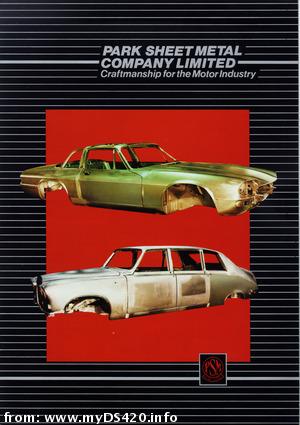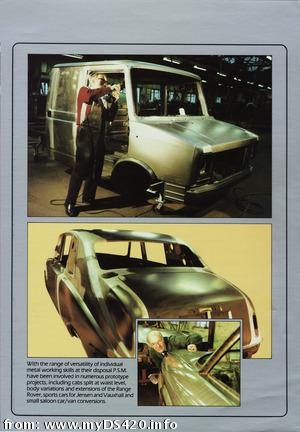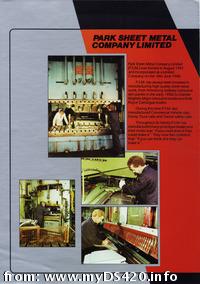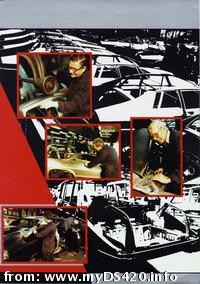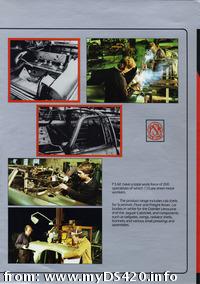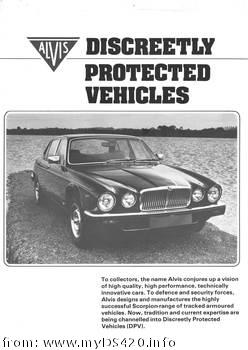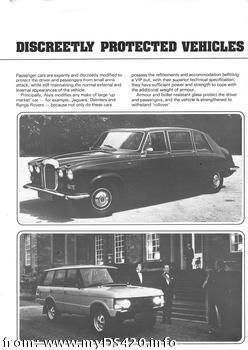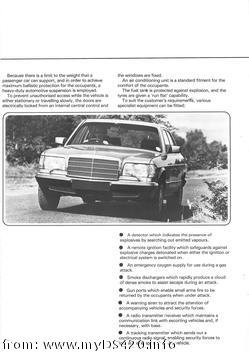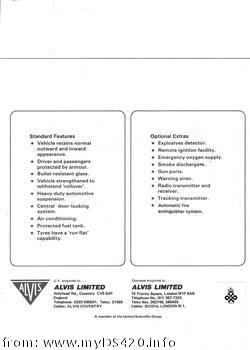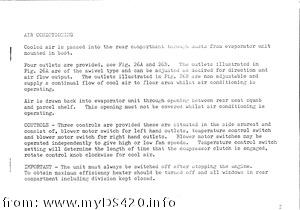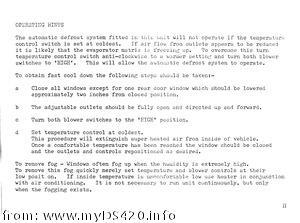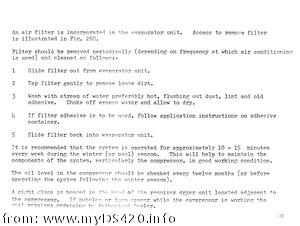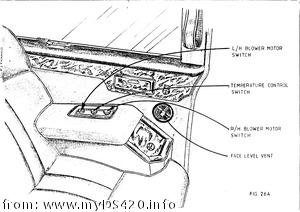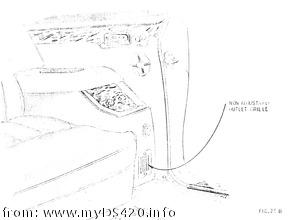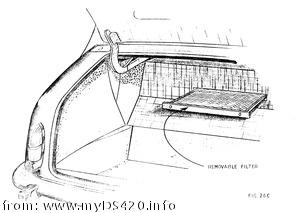| |
Daimler DS420 Various technical illustrations
|
|

|
This web page shows various technical illustrations.
Many of these are separate handouts that were added to the Owner's Manual,
but we start with a brochure from the Park Sheet Metal Company:
| |
This beautiful 1987 brochure from the Park Sheet Metal Company
of Coventry shows, among other models, DS420 body shells in production.
The pages can be enlarged by clicking.
The brochure has publication No. 2M/4.87
|
|
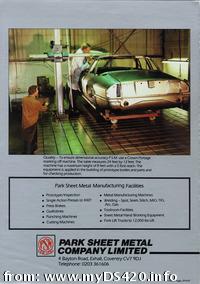
|
|
According to the book Daimler and Lanchester by Brian Long,
Park Sheet Metal assembled the bodies of the DS420 before
they were transported to the VandenPlas works in London/Kingsbury.
VandenPlas did the final assembly to make them ready for sale
(until all production was moved to Jaguar in Coventry in 1979).
Body parts were supplied to PSM by Motor Panels of Coventry
and by Pressed Steel Fisher. Also. PSM had built the very first
(three) prototypes of the car in 1967/68. This brochure dates from 1987,
which is 20 years later (and 8 years after the VandenPlas works closed);
but it states that PSM is still involved in producing the DS420 body shells.
A thumbnail photo of (early) parts manufacturing at Motor Panels of Coventry
is accessible via the archive search facility of the British Motor Industry
Heritage Trust at Gaydon: see it
here.
The reference code for this picture is: Nick Baldwin Collection NBP~2483~002.
|
During a visit to the Browns Lane factory, Stuart Holmes took
these photos of newly produced limousines and (hearse) chassis, awaiting their dispatch.
Stuart's Jaguar 420G is on the pictures as well.
Unfortunately, the original colors of the images have suffered.
But the scene is very interesting nevertheless.
The cars have the rubber bumpers which were introduced in 1987.
They still have the pressed steel wheels which were replaced by
alloy ones in the same year: 1987.
Click the illustrations to enlarge.
| |
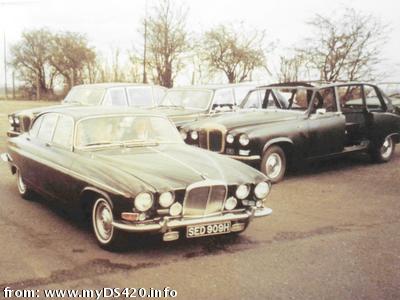
| |
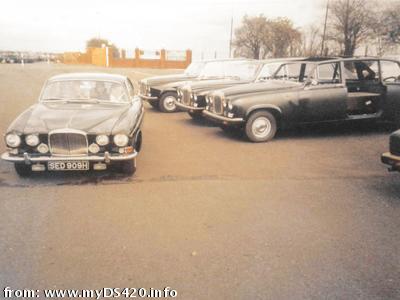
|
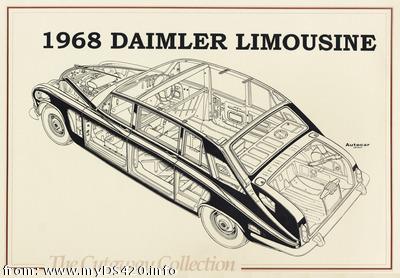
| |
The Autocar magazine was famous for its "cutaway" drawings of cars.
This one first appeared in an article of June 13, 1968
(see it on the page with
magazine articles
of this web site).
Note that June 11, 1968 was the official introduction of the DS420.
This drawing was republished e.g. in the Autocar of Oct. 17, 1968.
The latter issue was especially devoted to the "cutaways"
and showed a large number of them over several pages.
Click the illustration to enlarge it.
|
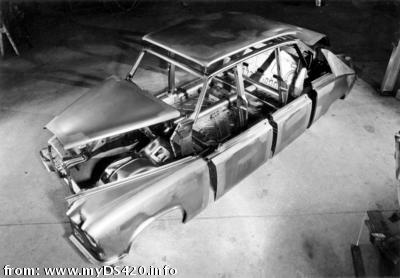
| |
Here is the real thing!
The car shown has the rectangular air inlets, so it dates from
after 1979.
This photo must have been taken at Jaguar's, or at Park Sheet Metal.
Click the illustration to enlarge it.
|
|
These crash test photographs show a very early body,
with a rear side window of the wind-down type.
The chrome air vents below the inner headlights are interesting:
they show the large V as was present on this same grille
when mounted on the Majestic Major: the V8-equipped predecessor of the DS420.
This V is a detachable piece on that grille, and it was left off for the
final production of the DS420.
I assume that that V on the photos indicates that this crash tested body
was indeed a very early one, if not even a pre production prototype.
The horizontal bar in the middle behind the grille of the car
is a strange element.
It was never present in production cars.
Another difference is that production cars had the bottom edge of the grille
behind the bumper, instead of above it.
The bad fit between the grille and the bonnet also
suggests that this grille was a preliminary one.
These tests were conducted at the Crash Laboratory of MIRA,
the Motor Industry Research Association in Nuneaton near Coventry.
This MIRA crash laboratory opened in 1968 and thus was brand new at the time these photos were taken.
|
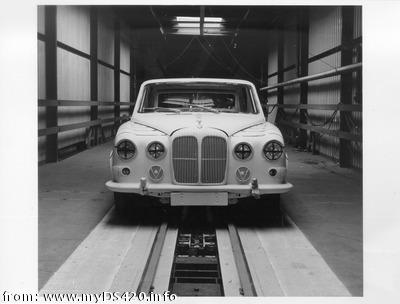
|
|
|
|
The overriders on the front bumper look
like they came from the Jaguar Mark X.
The bonnet of the Mark X hinges at the front,
and thus its overriders point upward/forward like cow horns,
as the pre-crash photo of the right side of the car clearly shows
(2nd row, left photo).
This probably caused the front bumper to fold downward
as it did at the impact, as can be seen on the various post-crash photos.
The photos of the driver's compartment, clearly meant to determine the
deformation of the steering column, suggest that the front window survived
the crash without damage, and even stayed in position.
On the last photo you may notice how the round emblem carriers
dropped off the centre of the round air inlet grilles.
A little pillar on their back passes through the grille
and a clip nut secures it from behind.
Trying to get them off by normal means invariably damages your fingers;
it is surprising that the impact managed to detach them so successfully.
|
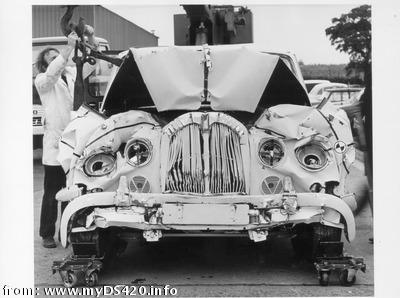
|
The web-page with
production figures
shows how the limousines and hearses changed to a 6-digit serial number format
halfway through 1979.
This was part of the international Vehicle Identification Number (VIN) format
adopted by manufacturers world wide. The table below picks out the
codes most common for DS420 limos, but you may have to enlarge the chart
to find the explanation of other code letters.
| 1-3 | Manufacturer Ident.: | SAD=Daimler, SAJ=Jaguar
In April 1987, Jaguar started using SAJ, even on Daimler Limousines.
|
| 4 | Vehicle Marque: | D=Daimler |
| 5 | Model Range: | W=Limousine |
| 6 | Class: | A=Baseline spec, V,Y=USA spec. |
| 7 | Body: | T=4 dr.Limo,
W=4 dr.hearse |
| 8 | Engine variant: | L=4.2 |
| 9 | Transmission/Steering: | 3=Auto/RHS, 4=Auto/LHS |
| 10 | Model,
or in Canada, USA & Korea: Year of built code
| A=Limo model |
| 11 | pre '87: C=Browns Lane Plant;
after '87 Emission control info
|
| 12-17 | Serial No.: from 200001=limo,
from 400001=hearse |
| |
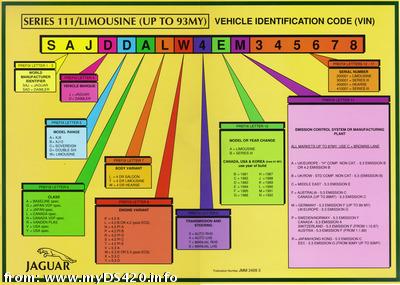
This chart has publication No. JMM 2499 3.
The RTC9887CD Parts Catalogue from 1985 states in its introduction that
the VIN-prefix for hearse-chassis is DWAZL3AC. According to the chart
shown here it would have been DWAWL3AC, but this is wrong.
Click
here
for a tabular overview of all DS420 numbers.
|
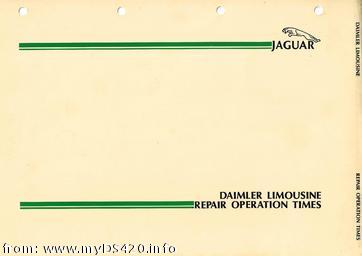
|
This is a "Repair Operation Times" specification from 1986.
It has 31 tabular pages, of which we show the first one here.
Click on an image or on an entry of the list to get access to the other pages.
The numbers approximately follow the Service
Manual AKM9135. The page-by-page sequence is:
- 01: Camshaft, Connecting Rods and Pistons, Crankshaft
- 02: Cylinder head, Engine assembly, Engine mounting, Flywheel and drive plate
- 03: Lubrication system, Timing gears, chains, tensioners and guides
- 04: Crankcase control system, Air inlet temperature control system
- 05: Air cleaners and hoses, Carburetters, Controls, Fuel filters
- 06: Fuel pipes and hoses, Fuel pump, Fuel tank
- 07: Coolant and system, Fan blades and pulleys, Radiator, Thermostat, Water pump
- 08: Exhaust system, Manifolds, Mountings
- 09: Brake bands, Clutches, Controls and linkage, Convertor and housing, Gearbox assembly and casings, Lubrication system
- 10: Manual valve, Park lock, Pressure and adjustment checks, Pump, Servos, Shafts and gears, Speedometer drive, Valve body
- 11: Drive shafts, Propellor shaft
- 12: Output shafts, Oil seals and gaskets, Final drive unit
- 13: Power steering box assembly, Power steering pump, Steering column, Steering wheel
- 14: Anti roll bar, Hub assemblies, Shock absorbers and stop rubbers, Suspension unit and wishbones
- 15: Hub assemblies, Rear road springs, Rear suspension unit
- 16: Shock absorbers and stop rubbers, Suspension wishbones and arms
- 17: Discs, Hoses and connectors, Hydraulic system, Master cylinder, Mechanical linkage, Shoes and pads, Vacuum system
- 18: Brake calipers
- 19: Body general, Body trim, Interior fixtures and fittings, Bonnet and lock
- 20: Boot lid and lock, Centre division glasses and frames, Centre console, Doors
- 21: Door glasses and frames, Door interior trim and finishers, Door locks, Exterior finishers and mouldings
- 22: Fascia, Veneer panels, Glove box, Grilles
- 23: Handles and pulls, Headlinings, Parcel and ashtrays, Seats, Seat belts, Sill tread plates
- 24: Controls, Demister and ventilators, Heater unit
- 25: Airco Compressor and drive, Liquid receiver/drier, Controls, Cooling unit
- 26: Windscreen washers, Windscreen wipers
- 27: Alternator and control unit, Battery, Electrically operated windows and locks, Horns, Ignition system
- 28: Exterior lamps
- 29: Interior lamps, Radio, Relays, units and modules, Seat belt warning system, Starter motor
- 30: Switches and cigar lighters
- 31: Battery condition indicator, Clock, Oil, coolant and fuel gauges, Speedometer and tachometer
|
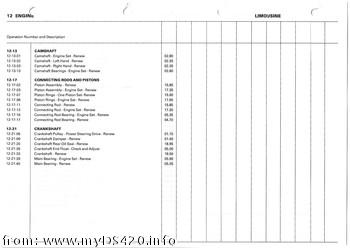
|
|
Tim Enloe provided a brochure dated October 2016 that was published by Wilcox. It advertises various steel repair panels
for the car's wheel arches and sills. The brochure text makes clear that supplies are drying up around that date.
I do not know when this batch was manufactured, but in 2005 I bought a set myself for the restoration of my first limousine.
These panels are clearly visible on several photos in the
photo gallery that documents this restoration.
In later years I have heard about the existence of plastic repair panels, but I have no details.
|
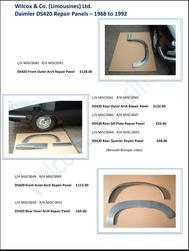
|
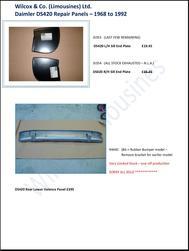
|
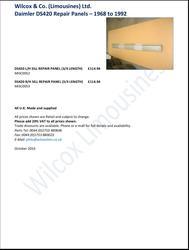
|
This brochure describes a whole list of protective measures that can be
applied to a DS420. It is an impressive list...
The brochure has no year, but the limousine photo is a
factory press photo from 1980,
and the last page has the logo for "The Queen's Award for Export"
with year 1982.
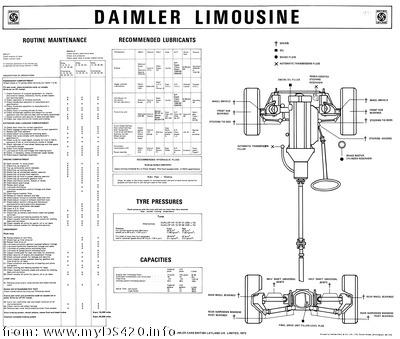
| |
This lubrication chart/poster was added to many early Owner's Manuals.
It measures 54×45 cm. The one shown here has publication No. E.1017/4,
and is copyrighted in 1972. It has the note: Printed by Haynes Clark
& Co., Ltd., 176 Gooch Street, Birmingham, B5 7HE.
If you click on the picture, you get a large version (61kB), but even
there the texts may not be easily readable. Therefore you can view the
three columns separately here:
An earlier edition of this lubrication chart, publication No. E.1017/3
(slightly larger than the above one: 56×49 cm.) has the same drawing,
and the same text in the Recommended Lubricants column.
The text in the leftmost column Routine Maintenance is different.
|
|
Around 1973 the Borg Warner 8 automatic gearbox was succeeded by the BW12.
The Owner's Manual 1038/1 from 1974 covers this BW12.
The Operating Details leaflet shown here was additional
to the edition before that.
Publication No. of the B&W leaflet: E.1037/1,
the white/red leaflet has no publication number.
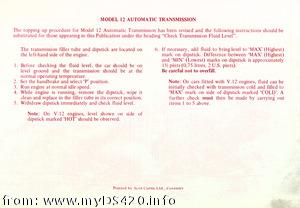
|
|
|
At about the same time, the carburettors changed from SU-HD8
to SU-H.S.8. This leaflet was added to the Owner's Manual before
its printing was adapted to the new carburettor.
It applies to cars with engine numbers from 7M2503 (which was late Spring 1973).
No publication number.
|
|
|
This leaflet, publ. No. AKM 3969, is also about the carburettors:
|
|
This publication (no publ.No. listed) came with a 1978 limousine sold in London.
It describes the use of the airco unit in the rear compartment:
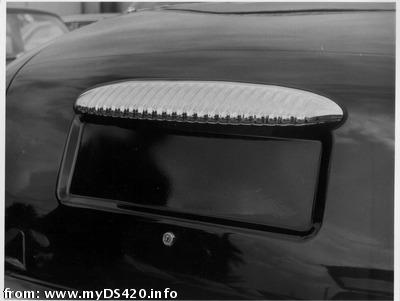
|
The JDHT provided a few photos focusing on technical details.
One shows the new boot lid with the long handle.
The other two show the steering lock key area.
The exact date of these photos is hard to determine.
The long boot lid handle was introduced in the summer of 1975.
The steering colomn lock was first added in Sept. 1969 on
chassis no. 1M1206 RHD and 1M20002 LHD.
The earliest DS420s have an ignition key lock
in the centre of the dashboard only.
My guess is that these two photos were published
to accompany the introduction of that steering lock.
As such, these steering lock photos (1969) are much older
than the boot lid photo (1975).
|
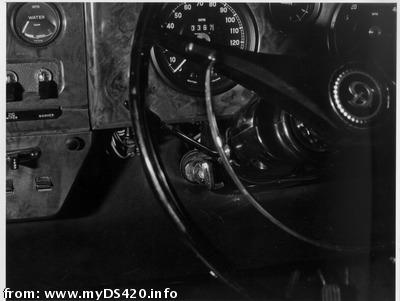
|
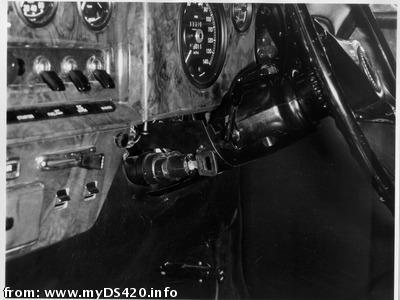
|
Back to the
index page.
page.


